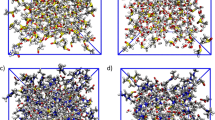Abstract
The components of the interfacial surface tension of talc and pyrophyllite were determined by measuring the rate of the capillary rise of a number of liquids through thin, sedimented deposits of the powdered minerals. The rate of capillary rise of a liquid in a powder is related to the contact angle between the liquid and the solid by the Washburn equation. The contact angles thus derived were used to determine the apolar (Lifshitzvan der Waals) component, γ LW, and the polar, electronacceptor and electron-donor parameters, γ ⊕ and γ ⊖ respectively, of the Lewis acid/base component of the total interfacial surface energy using the Young equation. The values of γ LW for talc and pyrophyllite (31.5 and 34.4 mJ/m2) are slightly smaller than for smectite clay minerals (e.g., the value for hectorite is 39.9 mJ/m2), the electron donor parameter values are roughly comparable for talc and pyrophyllite (γ ⊕ = 2.4 and 1.7 mJ/m2) as are the values of the electron acceptor parameter (γ ⊖ = 2.7 and 3.2 mJ/m2). The well-known hydrophobicity of these two minerals is due to the remarkably small value (for silicate minerals) of γ ⊖(γ⊕ is normally small or zero for silicates and many other oxides). The small values of both γ ⊕ and γ ⊖ mean that the Lewis acid/base interactions between talc or pyrophyllite and highly polar water molecules are very weak. In contrast, low-charge smectites, the minerals most similar chemically and structurally to talc and pyrophyllite, have much greater values of γ ⊖ (≥ 30 mJ/m2) and are hydrophyllic.
Similar content being viewed by others
References
Bartell FE and Zuidema HH (1936) Wetting characteristics of solids of low surface tension such as talc, waxes and resins. J Am Chem Soc 57:1449–1454
Brown ID (1978) Bond valences — A simple structural model for inorganic chemistry. Chem Soc Rev 7:359–376
Chaudhury MK (1984) Short Range and Long Range Forces in Colloidal and Macroscopic Systems. Ph.D. Thesis, SUNY at Buffalo, p 215
Costanzo PM, Giese RF, and van Oss CJ (1990) Determination of the acid-base characteristics of clay mineral surfaces by contact angle measurements — Implications for the adsorption of organic solutes from aqueous media. J Adhesion Sci Technol 4:267–275
Fowkes FM (1963) Additivity of intermoleculear forces at interfaces. I. Determination of the contribution to surface and interfacial tensions of dispersion forces in various liquids. J Phys Chem 67:2538–2541
Fowkes FM (1983) Acid-base interactions in polymer adhesion. In: Mittal KL (ed) Physicochemical Aspects of Polymer Surfaces, Plenum Press, New York, pp 583–603
Giese RF, van Oss CJ, Norris J, and Costanzo PM (1989) Surface energies of some smectite clay minerals: (Abstract) Int. Clay Conf., Strasbourg, France
Good RJ and Girifalco LA (1960) A theory for estimation of surface and interfacial energies. III. Estimation of surface energies of solids from contact angle data. J Phys Chem 64:561–565
Kelebek S (1987) Wetting behavior, polar characteristics and flotation of inherently hydrophobic minerals. Trans Inst Min Metall Sec C 103–107
Kelebek S, Smith GW, Finch JA (1987) Critical surface tension of wetting and flotation of hydrophobic solids. Sep Sci Technol 22:1527–1546
Newman ACD (1987) Chemistry of Clays and Clay Minerals: Monograph No. 6, Min. Soc., Wiley, New York, p 469
Pérez-Rodriguez JL, Sanchez del Villar LM, Sánchez-Soto PJ (1988) Effects of dry grinding on pyrophyllite. Clay Miner 23:399–410
Schrader ME, Yariv S (1990) Wettability of clay minerals. J Colloid Interface Sci 136:85–94
Solomon DH, Swift JD, Murphy AJ (1971) The acidity of clay minerals in polymerizations and related reactions. J Macrmol Sci Chem A5:587–601
Steenberg E and Harris PJ (1985) Surface-chemical and mineralogical properties relevant to the flotation of talc and other layer silicates. MINTEK, Mineral and Process Chemistry Division, Report M 209, p 18
van Oss CJ, Chaudhury MK, Good RJ (1987a) Monopolar surfaces. Adv Colloid Interface Sci 28:35–64
van Oss CJ, Good RJ, Chaudhury MK (1987b) Determination of the hydrophobic interaction energy — Application to separation processes. Separation Sci Technol 22:1–24
van Oss CJ, Chaudhury MK, Good RJ (1988) Interfacial Lifshitzvan der Waals and polar interactions in macroscopic systems. Chem Rev 88:927–941
van Oss CJ, Giese RF, Costanzo PM (1990) DLVO and non-DLVO interactions in hectorite. Clays & Clay Miner 38:151–159
Washburn EW (1921) The dynamics of capillary flow. Phys Rev 17:273–283
Weiss Z and Durovic S (1984) Polytypism of pyrophyllite and talc. Silikaty 28:289–309
Author information
Authors and Affiliations
Rights and permissions
About this article
Cite this article
Giese, R.F., Costanzo, P.M. & van Oss, C.J. The surface free energies of talc and pyrophyllite. Phys Chem Minerals 17, 611–616 (1991). https://doi.org/10.1007/BF00203840
Received:
Issue Date:
DOI: https://doi.org/10.1007/BF00203840




